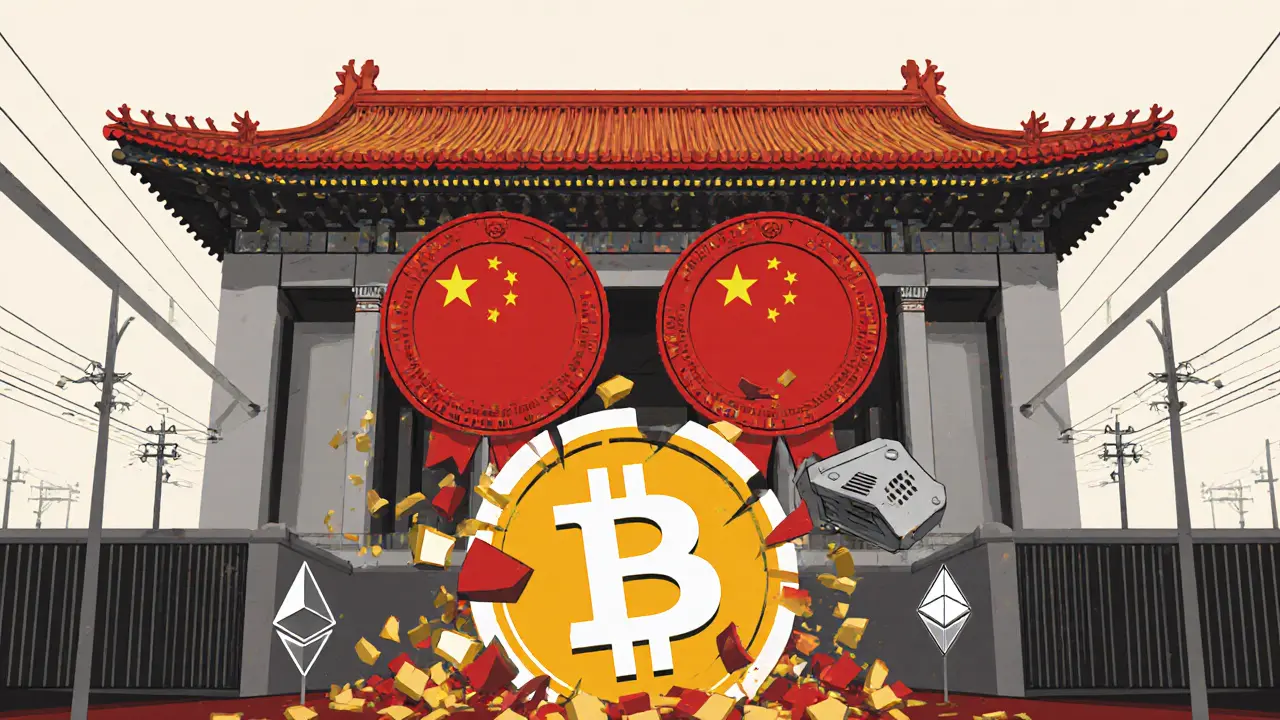China’s Crypto Mining Ban Is Complete - Here’s What It Actually Means
As of May 31, 2025, mining cryptocurrency in China is not just illegal - it’s a criminal offense. No exceptions. No gray areas. Not even for personal rigs in your basement. The government didn’t just shut down big mining farms. It made owning, trading, or mining any digital coin a punishable act under Chinese law. This isn’t a crackdown. It’s the final step in a 12-year plan to erase crypto from the country’s digital landscape.
Back in 2013, China warned banks not to handle Bitcoin transactions. By 2017, it banned ICOs and shut down local exchanges. In 2021, it ordered a full nationwide ban on mining. But even then, some miners kept running quietly - hidden in warehouses, basements, and rural power stations. The 2025 ban changed everything. Now, it’s not just about stopping operations. It’s about erasing the idea that crypto has any place in China’s economy.
Why Did China Go All-In on Banning Crypto Mining?
China didn’t ban crypto because it hated technology. It banned it because crypto threatened four core goals: energy control, financial sovereignty, crime prevention, and digital yuan dominance.
First - energy. Bitcoin mining guzzles power. In 2020, Chinese mining operations used more electricity than the entire country of Argentina. That’s a problem when China is trying to hit carbon neutrality by 2060. Mining rigs running 24/7 in Inner Mongolia or Sichuan were burning coal-fired power that could’ve gone to factories, hospitals, or homes. The government couldn’t justify that waste.
Second - control. Crypto moves money outside the banking system. People could send value across borders without the state seeing it. That’s a nightmare for a government that tracks every yuan spent. With crypto, capital flight became easier. Rich individuals and corporations could move assets out of China without triggering alarms. The State Administration of Foreign Exchange saw this as a direct threat to its ability to manage the economy.
Third - crime. Crypto is anonymous. That makes it perfect for money laundering, fraud, and ransomware payments. Chinese authorities linked crypto transactions to underground markets, drug rings, and offshore tax evasion. While not all crypto use is criminal, the anonymity made enforcement nearly impossible.
And fourth - the digital yuan. China spent over a decade building its own central bank digital currency, the e-CNY. It’s not just a digital version of cash. It’s a tool for total financial control. Every transaction is traceable. Every user is identifiable. Crypto, especially decentralized coins like Bitcoin, directly competes with that vision. The government didn’t want a parallel financial system. It wanted to own the system.
How the Ban Is Enforced - It’s Not Just Police Raids
China doesn’t rely on cops knocking on doors to catch miners. It uses infrastructure you can’t hide from.
Electricity monitoring is the biggest weapon. Power companies now flag unusual spikes in consumption - especially in industrial zones or residential buildings with no clear reason for high usage. A home using 10,000 kWh a month? That’s not normal. That’s a mining rig. Authorities get automatic alerts. They send inspectors. They cut power. Then they seize equipment.
Banks are locked down too. No financial institution in China can process crypto transactions. If you try to send money to a mining pool or buy ASIC miners online, your account gets flagged. Your name goes on a watchlist. Your access to credit, loans, or even mobile payments can be frozen.
The Cyberspace Administration tracks online activity. If you search for mining software, join a crypto forum, or download a wallet app, your IP gets logged. Combine that with facial recognition at hardware stores selling mining gear, and you’ve got a system that knows who’s doing what - even if you think you’re anonymous.
And the penalties? They’re serious. In 2024, over 300 people were arrested for crypto mining. In 2025, sentences included fines up to 500,000 RMB ($70,000), confiscation of all equipment, and prison terms of up to three years for repeat offenders. The government doesn’t just shut down operations - it makes an example of people.

What About Underground Mining? Is It Still Happening?
Yes - but barely.
Some miners still operate. Tiny setups. One or two rigs in remote villages. Hidden behind fake businesses. Power stolen from local grids. But it’s not sustainable. The risk is too high, and the rewards are shrinking.
Electricity costs have risen across China since the ban. The government raised rates for high-consumption users, making mining unprofitable even if you avoid detection. And the heat from enforcement is growing. In 2025, AI-powered energy pattern analysis was rolled out in 15 provinces. It can now detect mining activity from 200 meters away - just by analyzing grid load fluctuations.
China still accounts for about 5% of global Bitcoin hashrate, down from over 70% in 2020. That 5% comes from desperate, high-risk operators. Most have given up. The ones still mining are either too stubborn to quit or don’t have the resources to leave. Either way, they’re living on borrowed time.
The Global Fallout - Who Won When China Lost?
China’s ban didn’t kill crypto mining. It just moved it.
When the 2021 ban hit, miners fled to the U.S., Canada, Kazakhstan, and Russia. The U.S. became the new leader in Bitcoin mining, with Texas alone now hosting more hash power than all of China did in 2020. Kazakhstan briefly surged, but its own political instability and power shortages pushed miners to North America again.
Today, over 35% of Bitcoin’s global hash rate is in the U.S., mostly in states with cheap renewable energy like Georgia, Kentucky, and Washington. Canada’s Quebec and Ontario are also major players, thanks to hydroelectric power. Europe’s Norway and Sweden are growing fast, using clean energy to attract miners.
The market reacted hard. When the 2025 ban was announced, Bitcoin dropped from $111,000 to $104,500 in 24 hours. Ethereum fell 12%. Altcoins like Solana and Cardano lost up to 20%. Over $750 million in leveraged positions were liquidated. Investors who didn’t expect the ban to go this far got burned.
But the long-term effect? It made mining more decentralized. More resilient. Less vulnerable to one country’s policy swings. That’s good for the network - even if it hurt China’s economy.

What’s Next for China? The Digital Yuan Is the Only Game in Town
China isn’t waiting for crypto to come back. It’s moving forward with the digital yuan - and it’s not slowing down.
The e-CNY is now used in over 200 cities. More than 300 million people have active wallets. The government is pushing it for everything: taxes, salaries, welfare payments, even public transit. Every transaction is recorded. Every user is verified. There’s no anonymity. No decentralization. No competition.
There’s no indication the ban will ever be lifted. Not in 2025. Not in 2030. The leadership sees crypto as a threat to its control - and the digital yuan as its future. The two can’t coexist.
For miners, traders, or investors in China, the message is clear: don’t bother. The law isn’t going to change. The penalties aren’t going to soften. The technology isn’t going to become legal. The only path forward is to leave crypto behind - or risk losing everything.
What This Means for the Rest of the World
China’s ban teaches a brutal lesson: crypto regulation isn’t about innovation. It’s about power.
If you’re thinking of mining or investing in crypto, remember - one country’s decision can shake markets. One policy shift can erase billions. The days of crypto being a global free-for-all are over. Governments are waking up. They’re building their own systems. And they’re not afraid to crush the competition.
China didn’t ban crypto because it was afraid of technology. It banned it because it was afraid of losing control. And it won.
Is it still possible to mine crypto in China legally?
No. As of May 31, 2025, all forms of cryptocurrency mining, trading, and ownership are illegal in China. There are no legal exceptions, even for personal use. Any mining activity, no matter how small, is considered a criminal offense under Chinese law.
What happens if you get caught mining crypto in China?
If caught, you face severe penalties. Equipment is seized immediately. Fines can reach 500,000 RMB ($70,000). Repeat offenders or those running large operations may face prison sentences of up to three years. Authorities use electricity monitoring, banking checks, and AI-driven surveillance to detect mining, so hiding it is extremely difficult.
Why did China ban crypto mining but allow blockchain?
China distinguishes between blockchain technology and cryptocurrency. Blockchain - the underlying ledger system - is allowed because it can be controlled and used for government purposes like supply chain tracking or public records. But cryptocurrencies like Bitcoin are decentralized and untrackable, which the government sees as a threat to financial control. Only state-approved blockchain applications are permitted.
Can Chinese citizens own Bitcoin or other cryptocurrencies?
No. Since the May 2025 comprehensive ban, owning any cryptocurrency is illegal in China. This includes holding coins in wallets, exchanges, or private keys. Authorities treat possession as equivalent to mining or trading - all are criminal acts. Financial institutions are required to freeze accounts linked to crypto ownership.
Has China’s ban affected global crypto prices?
Yes. The May 2025 ban triggered a market crash. Bitcoin dropped from $111,000 to $104,500 within 24 hours. Ethereum and altcoins like Solana and Cardano fell by 12-20%. Over $750 million in leveraged positions were liquidated. The ban confirmed that major economies can still disrupt crypto markets through regulation.
Where did Chinese miners go after the ban?
Most relocated to the United States, Canada, Kazakhstan, and parts of Europe. The U.S. became the new leader in Bitcoin mining, especially in Texas and Washington, where cheap renewable energy is available. Canada’s hydro-powered provinces like Quebec also absorbed large numbers of miners. These regions now host over 35% of the global Bitcoin hash rate.
Is there any chance China will reverse its crypto ban?
No. There is no indication of a reversal. China’s focus is entirely on expanding the digital yuan (e-CNY), which is now used by over 300 million people. The government views crypto as incompatible with its goal of full financial control. Experts agree the 2025 ban is permanent - it’s the final stage of a 12-year strategy to eliminate decentralized digital currencies.
How does China track crypto mining if it’s underground?
China uses a multi-layered surveillance system. Electricity providers flag abnormal power usage. Banks monitor transactions linked to mining hardware purchases. The Cyberspace Administration tracks downloads of mining software and crypto wallet apps. AI systems now detect mining patterns from grid load data alone - even without physical access. Facial recognition at hardware stores also helps identify buyers.

Sara Lindsey
November 15, 2025 AT 12:30Also who else is glad the hash rate got decentralized? No more single country holding 70% of the network. That's just good for Bitcoin.
alex piner
November 17, 2025 AT 05:03Gavin Jones
November 18, 2025 AT 07:01Mauricio Picirillo
November 19, 2025 AT 11:56Liz Watson
November 19, 2025 AT 21:56Rachel Anderson
November 21, 2025 AT 18:59Hamish Britton
November 22, 2025 AT 09:14Robert Astel
November 23, 2025 AT 14:54Andrew Parker
November 24, 2025 AT 20:40Kevin Hayes
November 25, 2025 AT 16:36Katherine Wagner
November 26, 2025 AT 18:19ratheesh chandran
November 28, 2025 AT 16:37Hannah Kleyn
November 30, 2025 AT 10:28gary buena
December 2, 2025 AT 02:54Vanshika Bahiya
December 3, 2025 AT 14:27Albert Melkonian
December 5, 2025 AT 05:14Kelly McSwiggan
December 5, 2025 AT 11:25also… the fact that they think they can just ‘erase’ crypto is hilarious. it’s not a file you delete. it’s a protocol. it’s everywhere now.
Byron Kelleher
December 6, 2025 AT 13:08